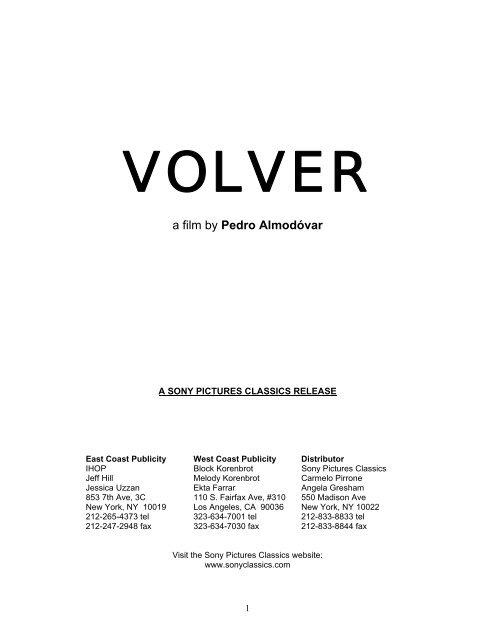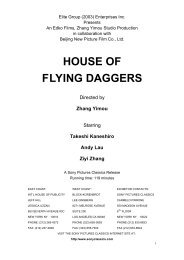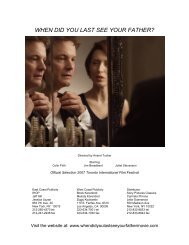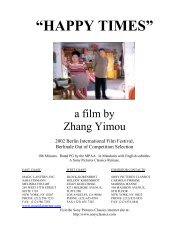You also want an ePaper? Increase the reach of your titles
YUMPU automatically turns print PDFs into web optimized ePapers that Google loves.
<strong>VOLVER</strong><br />
a film by Pedro Almodóvar<br />
A SONY PICTURES CLASSICS RELEASE<br />
East Coast Publicity West Coast Publicity Distributor<br />
IHOP Block Korenbrot <strong>Sony</strong> <strong>Pictures</strong> <strong>Classics</strong><br />
Jeff Hill Melody Korenbrot Carmelo Pirrone<br />
Jessica Uzzan Ekta Farrar Angela Gresham<br />
853 7th Ave, 3C 110 S. Fairfax Ave, #310 550 Madison Ave<br />
New York, NY 10019 Los Angeles, CA 90036 New York, NY 10022<br />
212-265-4373 tel 323-634-7001 tel 212-833-8833 tel<br />
212-247-2948 fax 323-634-7030 fax 212-833-8844 fax<br />
Visit the <strong>Sony</strong> <strong>Pictures</strong> <strong>Classics</strong> website:<br />
www.sonyclassics.com<br />
1
SYNOPSIS<br />
<strong>VOLVER</strong> is a meeting of “Mildred Pierce” and “Arsenic and Old Lace”, combined with<br />
the surrealistic naturalism of my fourth film, “¿Qué he hecho yo para merecer esto!!”<br />
(“What have I done to Deserve This?”), that is, Madrid and its lively working-class<br />
neighbourhoods, where the immigrants from the various Spanish provinces share<br />
dreams, lives and fortune with a multitude of ethnic groups and other races. At the<br />
heart of this social framework, three generations of women survive wind, fire and even<br />
death, thanks to goodness, audacity and a limitless vitality.<br />
They are Raimunda (Pénelope Cruz), who is married to an unemployed labourer and<br />
has a teenage daughter (Yohana Cobo); Sole (Lola Dueñas), her sister, who makes a<br />
living as a hairdresser; and the mother of both (Carmen Maura), who died in a fire<br />
along with her husband. This character appears first to her sister (Chus Lampreave)<br />
and then to Sole, although the people with whom she has some unresolved matters are<br />
Raimunda and her neighbour in the village, Agustina (Blanca Portillo).<br />
<strong>VOLVER</strong> is not a surrealistic comedy although it may seem so at times. The living and<br />
the dead coexist without any discord, causing situations that are either hilarious or filled<br />
with a deep, genuine emotion. It’s a film about the culture of death in my native La<br />
Mancha. The people there practice it with an admirable naturalness. The way in which<br />
the dead continue to be present in their lives, the richness and humanity of their rites<br />
mean that the dead never die.<br />
<strong>VOLVER</strong> destroys all the clichés about “black” Spain and offers a Spain that is as real<br />
as it is the opposite. A Spain that is white, spontaneous, funny, intrepid, supportive and<br />
fair.<br />
2
ABOUT THE SCRIPT<br />
Most of the writers I know are very interested in cinema. Some of them are friends of<br />
mine. Lola, my assistant, sent the script of “Volver” to Juan José Millás and Gustavo<br />
Martín Garzo. These were their replies, words which they never thought I would use<br />
parasitically in this pressbook.<br />
From: Juan José Millás<br />
To: Lola García<br />
Re: Volver<br />
Dear Lola,<br />
I read the script in no time. The hyperrealism of the first scenes places you in a<br />
situation of great emotional tension. Hyperrealist painting has been given that name<br />
because they didn’t know exactly how it differs from realist painting. In this country, we<br />
have always confused realism with the portrayal of local customs. Flemish painting is<br />
hyperrealist because it is fantastic, because it places us in a dimension of reality that<br />
allows us to be surprised by the most everyday situations. Once Pedro has placed us<br />
in that situation at the beginning, which is resolved with the appearance of the ghost in<br />
the trunk of the car, he can do what he wants with the spectator. And that’s what he<br />
does. “Volver” is a permanent narrative conjuring trick, a prodigious device. And you<br />
never know where the trick is.<br />
In this script there is no frontier that Pedro hasn’t dared cross. He moves on the line<br />
that separates life from death like a tightrope walker. He mixes narrative materials from<br />
apparently incompatible origins with an amazing naturalness. And the more materials<br />
he adds, the greater the internal logic of the story…<br />
P.S. I couldn’t help, while reading “Volver”, recalling “Pedro Páramo”. Rulfo’s novel has<br />
got nothing to do with Pedro’s script, except in the naturalness with which both manage<br />
to have the dead co-existing with the living; the real with the unreal; the fantastic with<br />
the mundane; the imagined with the experienced; sleep with wakefulness. While<br />
reading the script, as happens while reading Rulfo’s novel, the reader has a permanent<br />
oneiric sensation. He is awake, of course, but trapped in a dream, the story he is<br />
reading. The strange thing is that Rulfo’s novel is furiously Mexican in the same way<br />
that Pedro’s script is furiously Manchegan…<br />
3
SHOOTING <strong>VOLVER</strong><br />
The most difficult thing about “Volver” has been writing its synopsis.<br />
My films are becoming more and more difficult to tell and summarize in a few lines.<br />
Fortunately, this difficulty has not been reflected in the work of the actors, or of the<br />
crew. The shooting of “Volver” went like clockwork.<br />
I guess I enjoyed it more because the last shoot (“Bad Education”) was absolute hell. I<br />
had forgotten what it was like to shoot without having the feeling of being permanently<br />
on the edge of the abyss. This doesn’t mean that “Volver” is better than my previous<br />
film, (in fact, I’m very proud of having made “Bad Education”), just that this time I<br />
suffered less. In fact, I didn’t suffer at all.<br />
In any case, “Bad Education” confirmed something essential for me (which I had<br />
discovered already, in “Matador” and “Live Flesh”): you can’t throw in the towel. Even if<br />
you’re convinced that your work is a disaster, you have to keep fighting for every shot,<br />
every repetition, every look, every silence, every tear. You mustn’t lose an iota of<br />
enthusiasm even if you’re in despair. The passing of time gives you another<br />
perspective and at times things weren’t as bad as you thought.<br />
4
CONFESSION<br />
“Volver” (Coming back) is a title that includes several kinds of coming back for me. I<br />
have come back, a bit more, to comedy. I have come back to the female world, to La<br />
Mancha (undoubtedly this is my most strictly Manchegan film, the language, the<br />
customs, the patios, the sobriety of the facades, the cobbled paving in the streets). I<br />
am working again with Carmen Maura (after seventeen years), with Penélope Cruz,<br />
Lola Dueñas and Chus Lampreave. I have come back to maternity, as the origin of life<br />
and of fiction. And naturally, I have come back to my mother. Coming back to La<br />
Mancha is always to come back to the maternal breast.<br />
During the writing of the script and the filming, my mother was always present and very<br />
near. I don’t know if the film is good (I’m not the one to say), but I’m sure that it did me<br />
a lot of good to make it.<br />
I have the impression, and I hope it’s not a passing feeling, that I have managed to slot<br />
in a piece whose misalignment has caused me a lot of pain and anxiety throughout my<br />
life, I would even say that in recent years it had damaged my existence, dramatizing it<br />
too much). The piece I am talking about is “death”, not just mine and that of my loved<br />
ones but the merciless disappearance of all that is alive. I have never accepted or<br />
understood it. And that puts you in a distressing situation when faced with the<br />
increasingly faster passing of time.<br />
The most important thing that comes back in “Volver” is the ghost of a mother, who<br />
appears to her daughters. In my village those things happen (I grew up hearing stories<br />
of apparitions), yet I don’t believe in apparitions. Only when they happen to others, or<br />
when they happen in fiction. And this fiction, the one in my film (and here comes my<br />
confession) has produced a serenity in me such as I haven’t felt for a long time (really,<br />
serenity is a word whose meaning is a mystery to me).<br />
I have never in my life been a serene person (and it’s never mattered to me in the<br />
slightest). My innate restlessness, along with a galloping dissatisfaction, has generally<br />
acted as a stimulus. It’s been in recent years that my life has gradually deteriorated,<br />
consumed by a terrible anxiety. And that wasn’t good either for living or for working. In<br />
order to direct a film, it’s more important to have patience than to have talent. And I had<br />
lost all patience a long time ago, particularly with trivial things which are what require<br />
most patience. This doesn’t mean that I have become less of a perfectionist or more<br />
complacent, not at all. But I believe that with “Volver” I have recovered part of my<br />
“patience”, a word which naturally entails many other things.<br />
I have the impression that, through this film, I have gone through a mourning period<br />
that I needed, a painless mourning (like that of the character of Agustina the neighbor).<br />
I have filled a vacuum, I have said goodbye to something (my youth?) to which I had<br />
not yet said goodbye and needed to, I don’t know. There is nothing paranormal in all<br />
this. My mother hasn’t appeared to me, although, as I said, I felt her presence closer<br />
than ever.<br />
“Volver” is a tribute to the social rites practiced by the people of my village with regard<br />
to death and the dead. The dead never die. I have always admired and envied the<br />
naturalness with which my neighbors talk of the dead, cultivate their memory and tend<br />
their graves constantly. Like the character of Agustina in the film, many of them look<br />
after their own grave for years, while they are alive. I have the optimistic feeling that I<br />
have been impregnated with all that and that some of it has stayed with me.<br />
5
I never accepted death, I’ve never understood it (I’ve said that already). For the first<br />
time, I think I can look at it without fear, although I continue to neither understand nor<br />
accept it. I’m starting to get the idea that it exists.<br />
Despite being a non-believer, I’ve tried to bring the character (of Carmen Maura) from<br />
the other world. And I’ve made her talk about heaven, hell and purgatory. And, I’m not<br />
the first one to discover this, the other world is here. The other world is this one. We<br />
are hell, heaven or purgatory, they are inside us. Sartre put it better than I.<br />
6
LETTER FROM GUSTAVO MARTÍN GARZO<br />
Dear Pedro, I really liked the script of your new film. Everything in it seems very familiar<br />
to me, very much you. It reminds me of the world of “What Have I Done to Deserve<br />
This?!” But it is less baroque, there is a transparency in it that situates us again in that<br />
world, it couldn’t be otherwise, but at the same time in a different, more poetic, wiser,<br />
more touching way. That mixture of horror and happiness is wonderful. As if your<br />
characters could always find in the midst of hell, as Calvino wanted, that which isn’t<br />
hell, and they’ll always manage to make it last in their lives. That mixture, so typically<br />
yours, of candor and perverseness which makes the most dreadful things funny, and<br />
manages to find beauty and hope where it seems they can’t exist, seems to me one of<br />
the most marvelous things in your films.<br />
Your script reminded me of a story that Tolstoy tells somewhere. A priest visits an<br />
isolated monastery in the Greek islands and finds four monks. He discovers that they<br />
don’t know the Our Father and, shocked, he teaches it to them. Then he takes his<br />
leave of them. When he is far from the coast he sees something gliding rapidly across<br />
the water towards his boat. He looks harder and sees that it is the monks whom he has<br />
just visited. They are running over the water! When they catch up with him they tell him<br />
they have forgotten the prayer he has just taught them, and ask him to repeat it. The<br />
priest, filled with emotion, replies that they don’t have to remember it, they don’t need it.<br />
That is how the characters in your film seem to me. They come to us, vulnerable and<br />
lost, to ask us for help, but they do it running over the water. They don’t realize, but that<br />
is the strange, wonderful path they follow to reach us. And then, what can we tell them?<br />
That it doesn’t matter what happens to them, what they suffer, what strange, terrible<br />
things may happen to them, we are not the ones to judge them. What’s more, they are<br />
the ones who could judge us, even though we know they never will, because they<br />
aren’t obsessed with justice but with love. And the best thing they can do is to continue<br />
being as they are.<br />
That is how I see this script, like a tale. There are terrible things in tales: people being<br />
chopped up, fathers who want to sleep with their adolescent daughters, children who<br />
are abandoned in a forest, fierce creatures who devour human flesh… The most<br />
extreme has a place in them, and yet, alongside that horror, there is always that rare<br />
thing we call innocence. It’s very hard to define what it is but there is nothing easier to<br />
identify when it appears. I think that art exists to pursue that innocence, which usually<br />
appears in the darkest places…<br />
7
THE RIVER<br />
The happiest memories of my childhood are related to the river.<br />
My mother used to take me with her when she went to wash clothes there because I<br />
was very little and she had no one with whom to leave me. There were always several<br />
women washing clothes and spreading them out on the grass. I would sit near my<br />
mother and put my hand in the water, trying to stroke the fish that answered the call of<br />
the fortuitously ecological soap the women used back then and which they made<br />
themselves.<br />
The river, the rivers, they were always a celebration. It was also in the waters of a river<br />
where, a few years later, I discovered sensuality.<br />
Undoubtedly the river is what I miss most from my childhood and adolescence.<br />
The women would sing while they were washing. I’ve always liked female choirs. My<br />
mother used to sing a song about some gleaners who would greet the dawn working in<br />
the fields and singing like joyful little birds. I sang the fragments that I remembered to<br />
the composer on “Volver”, my faithful Alberto Iglesias, and he told me it was a song<br />
from the operetta “La rosa del azafrán”. In my ignorance, I would never have thought<br />
that that heavenly music was an operetta. That is how the theme has become the<br />
music that accompanies the opening credits.<br />
In “Volver”, Raimunda is looking for a place to bury her husband and she decides to do<br />
it on the banks of the river where they met as children.<br />
The river, like the graphics of any transport, like tunnels or endless passageways, is<br />
one of many metaphors for time.<br />
8
GENRE AND TONE<br />
I suppose that “Volver” is a dramatic comedy. It has funny sequences and dramatic<br />
sequences. Its tone imitates “real life” but it isn’t a portrayal of local customs. Rather it<br />
has a surreal naturalism, if that were possible. I’ve always mixed genres and I still do.<br />
For me, it’s something natural.<br />
The idea of including a ghost in the plot is a basically comic element, particularly if you<br />
treat it in a realistic way. All of Sole’s attempts to hide the ghost from her sister, or the<br />
way she introduces her to her clients, give rise to very comic scenes.<br />
Although what happens in Raimunda’s house (the death of the husband) is terrible, the<br />
way in which she fights so that no one should find out and the way she tries to get rid of<br />
him also create comic situations.<br />
Although mixing genres is something natural for me, that doesn’t mean it’s free of risk<br />
(the grotesque and the “grand guignol” are always a threat). When you move between<br />
genres and cross opposing tones in a matter of seconds, the best thing is to adopt a<br />
naturalistic interpretation that manages to make the most ludicrous situation plausible.<br />
The only weapon that you have, apart from a realistic setting, are the actors, or rather,<br />
the actresses, in this case. I had the good fortune that they are all in a constant state<br />
of grace.<br />
They are the great spectacle in “Volver”.<br />
9
FAMILY<br />
“Volver” is a film about the family, and made with the family. My own sisters were the<br />
advisers on what happened both in La Mancha and inside the houses in Madrid (the<br />
hair salon, the meals, cleaning materials, etc.)<br />
Although they were more fortunate, my family, like that of Sole and Raimunda, is a<br />
migrant family which came from the village to the big city in search of prosperity.<br />
Fortunately my sisters have continued to cultivate the culture of our childhood and have<br />
kept intact the inheritance received from my mother. I moved away from home very<br />
young and became an inveterate urbanite. When I return to the habits and customs of<br />
La Mancha, they are my guides.<br />
The family in “Volver” is a family of women. The grandmother who has come back is<br />
Carmen Maura, her two daughters are Lola Dueñas and Penélope Cruz. Yohana Cobo<br />
is the granddaughter and Chus Lampreave is Aunt Paula, who still lives in the village.<br />
This group would have to include Agustina, the neighbor in the village (Blanca Portillo),<br />
the one who knows many of the family’s secrets, the one who has heard so many<br />
things, the one who, as soon as she gets up, taps on Aunt Paula’s window and doesn’t<br />
let up until the old lady answers, the one who brings her a full stick of bread every day,<br />
the one who finds her dead and calls Sole in Madrid. The one who opens her home to<br />
the corpse in order to give it a proper wake until the nieces arrive. The one who<br />
converts her mourning for the neighbor into mourning for her own mother, who<br />
disappeared years before, she doesn’t know where. The character of Agustina is, in<br />
her own right, part of the family that is headed by Carmen Maura.<br />
Agustina represents a very important element in this female universe: the solidarity of<br />
neighboring women. The women in the village spread out problems, they share them.<br />
And they manage to make life much more bearable. The opposite also happens (the<br />
neighbor who hates the neighbor and stores his hatred from generation to generation<br />
until one day the tragedy explodes and even they don’t know why). I have only paid<br />
attention to the positive part of that Deep Spain, which is what I experienced as a child.<br />
In fact, “Volver” pays tribute to the supportive neighbor, that unmarried or widowed<br />
woman who lives alone and makes the life of the old lady next door her own life. For a<br />
great part of her final years, my mother was helped by her closest neighbors.<br />
Those women were the inspiration for Agustina, a magnificent creation thanks to<br />
Blanca Portillo. For me she is the real revelation, because I didn’t know her. I had only<br />
seen her in a play and I liked her, but I couldn’t imagine that, with barely any film<br />
experience, she would be such a precise, polished actress, overwhelming in her<br />
continence. Agustina, alone in the empty street, watching as Sole’s car disappears, is<br />
the image of rural solitude, stripped of all adornment.<br />
Blanca absorbed the essence of all the good neighbors in my village and made it her<br />
own.<br />
10
THE STRENGTH AND FRAGILITY OF PENÉLOPE CRUZ<br />
And her beauty. Penélope is at the height of her beauty. It’s a cliché but in her case it’s<br />
true. (Those eyes, her neck, her shoulders, her breasts!! Penélope has got one of the<br />
most spectacular cleavages in world cinema). Looking at her has been one of the great<br />
pleasures of this shoot. Although she has become stylized in the last few years,<br />
Penélope showed (from her debut in “Jamón, jamón”) that she has more force in<br />
plebeian characters than in very refined ones. Seven or eight years ago, in “Live<br />
Flesh”, she played an uncouth hooker who goes into labor and gives birth on a bus.<br />
They were the first eight minutes of the film and Penélope literally devoured the screen.<br />
Her Raimunda in “Volver” belongs to the same stock as Carmen Maura’s character in<br />
“What Have I done to Deserve This?!”, a force of nature that isn’t daunted by anything.<br />
Penélope can come up with that overwhelming energy, but Raimunda is also a fragile<br />
woman, very fragile. She can (and must, because of the script) be furious and a<br />
moment later collapse like a defenseless child. This disarming vulnerability is what<br />
surprised me most about Penélope-actress, and the speed with which she can get in<br />
touch with it. There isn’t a more impressive spectacle than watching in the same shot<br />
how a pair of dry, threatening eyes suddenly start to fill with tears, tears that at times<br />
spill over like a torrent or, as in some sequences, only fill her eyes without ever spilling<br />
over. Witnessing that balance in imbalance has been thrilling.<br />
Penélope Cruz is a strong minded actress, but it is the mixture with that sudden,<br />
devastating emotion which makes her indispensable in “Volver”.<br />
It was a pleasure to dress, comb and make up the character and the person.<br />
Penélope’s body ennobles whatever you put on it. We decided on straight skirts and<br />
cardigans because they are classic garments, very feminine and popular in any<br />
decade, from the 1950s to 2000. And, it also must be said, because they reminded us<br />
of Sophia Loren, in her beginnings as a Neapolitan fish seller. We have to thank the<br />
hairdresser Massimo Gattabrusi for the wonderful disheveled hair-dos and Ana Lozano<br />
for the make-up. The extended eye line was a real find. There is just one false element<br />
in Raimunda’s body, her ass. These characters are always big-assed women and<br />
Penélope is too slim. The rest is all heart, emotion, talent, truth, and a face that the<br />
camera adores. As I do.<br />
11
THE RETURN OF CARMEN<br />
I never imagined that there was so much expectation about our re-encounter. I’m<br />
surprised by the number of people who told me how happy they were that Carmen and<br />
I were working together again! A song by Chavela says: “you always go back to the old<br />
places where you loved life”. That can also be applied to people.<br />
There is always uncertainty, but fortunately Carmen’s disappeared at our first work<br />
meetings.<br />
There is a long sequence in the script of “Volver”, almost a monologue, because only<br />
Carmen’s character, the grandmother’s ghost, speaks. In this sequence, Carmen<br />
explains to her beloved daughter, Penélope Cruz, the reasons for her death and her<br />
return, over the course of six intense pages and six equally intense shots. This<br />
sequence is one of the reasons why I wanted to make the film. I cried each and every<br />
time I corrected the text (like the character played by Kathleen Turner in “Romancing<br />
the Stone”, a ridiculous writer of very kitsch, romantic novels who cried while she was<br />
writing).<br />
The night we filmed it, the whole crew was aware of its importance. There was a lot of<br />
expectation. That made Carmen a bit nervous and she wanted it to tackle it as soon as<br />
she could.<br />
We took a whole night to film it and everyone from the trainee to me had that extreme<br />
concentration you get with difficult scenes and which precisely because of that makes<br />
them the easiest scenes, because we all give the most of ourselves.<br />
Once again I felt that sacred complicity with Carmen, that marvelous feeling of being in<br />
front of an instrument that was perfectly tuned for my hands. All the takes were good,<br />
and many of them were extraordinary. Penélope is listening to her, at times with her<br />
head down. In the film, there is a lot of talking, there is a lot that is hidden and, for a<br />
comedy (so the crew says) there is a lot of crying.<br />
From “Women on the Verge…” to the monologue in “Volver”, Carmen hasn’t changed<br />
as an actress, and it was wonderful to discover that. She hasn’t learned anything<br />
because she knew it all already, but keeping that fire intact over two decades is an<br />
admirable, difficult task that can’t be said of all the actors with whom I’ve worked.<br />
The rest of the cast has been on a level with their companions. Lola Dueñas probably<br />
gives one of her most complex performances. She is the most eccentric of the four<br />
women in her family. Lola undertook personally to dominate the complicated<br />
Manchegan accent. She learned the secrets of the hairdressing trade and developed a<br />
comic streak unknown in her. She is intense, authentic and rare, in the best sense of<br />
the word.<br />
Another of the blessings on this shoot was that all the girls lived and worked very<br />
closely. They had a wonderful relationship, like a family. And the lens captured that too.<br />
I’m very moved by young Yohana Cobo’s performance. She is present in almost all the<br />
sequences but as a witness. She does one of the most complicated things in acting,<br />
which is listening and being present. And her presence is eloquent while doing hardly<br />
anything. But Yohana’s work is conscious, subtle and very rich. Apart from “her”<br />
sequences, her monologue in front of her dead father… etc, the rest, always close to<br />
her mother, understanding her without knowing what is wrong with her, provokes a<br />
great tenderness in me. She also has an abrasive look. I hope everything goes well for<br />
her.<br />
12
Chus Lampreave, María Isabel Díaz, Neus Sanz, Pepa Aniorte and Yolanda Ramos<br />
complete the cast, along with Antonio de la Torre, Carlos Blanco and Leandro Rivera.<br />
José Luís Alcaine, behind the camera, Alberto Iglesias, with the music, and Pepe<br />
Salcedo, as editor, have once again tuned in to my secret intentions, each one in his<br />
respective area.<br />
13
PEDRO ALMODÓVAR – BIOGRAPHY<br />
He was born in Calzada de Calatrava, province of Ciudad Real, in the heart of La<br />
Mancha, in the 50s. When he was eight, he emigrated with his family to Estremadura.<br />
There he studied for his elementary and high school diplomas in spite of the Salesian<br />
Fathers and the Franciscans.<br />
At seventeen, he left home and moved to Madrid, with no money and no job, but with a<br />
very specific project in mind: to study cinema and direct films. It was impossible to<br />
enroll in the Official Film School because Franco had just closed it. As he couldn’t learn<br />
the language, he decided to learn the content, that is, life, living… Despite the<br />
dictatorship that was suffocating the country, for an adolescent from the provinces<br />
Madrid represented culture, independence and freedom. He worked at many, sporadic<br />
jobs but couldn’t buy his first Super-8mm camera until he got a “serious” job at the<br />
National Telephone Company of Spain where he worked for twelve years as an<br />
administrative assistant, twelve years which he also devoted to multiple activities which<br />
provided his real training as a filmmaker and as a person. In the mornings, in the<br />
Telephone Company, he got an in-depth knowledge of the Spanish middle class at the<br />
start of the consumer era, its dramas and its misfortunes, a real gold mine for a future<br />
story teller. In the evenings and nights, he wrote, loved, acted with the mythical<br />
independent theater group Los Goliardos and made films in Super-8 (his only school as<br />
a filmmaker). He collaborated with various underground magazines and wrote stories,<br />
some of which were published. He was a member of a parodic punk-rock group,<br />
Almodóvar and McNamara, etc.<br />
He had the good fortune that the opening of his first film in commercial cinemas<br />
coincided with the beginning of democracy in Spain. After 18 months of eventful<br />
shooting on 16mm, in 1980 he opened “Pepi, Luci, Bom…”, a no-budget film made as<br />
a cooperative effort with the rest of the crew and the cast, all beginners, except for<br />
Carmen Maura. In 1986, he founded the production company El Deseo S.A. with his<br />
brother Agustín. Their first project was “Law of Desire”. Since then, they have produced<br />
all the films that Pedro has written and directed, and have also produced other young<br />
directors.<br />
In 1988, “Women on the Verge of a Nervous Breakdown” brought him international<br />
recognition. Since then, his films have opened all around the world. With “All About my<br />
Mother” he won his first Academy Award for Best Foreign Film, and also the Golden<br />
Globe, the César, 3 European Film Awards, the David de Donatello, 2 BAFTAs, 7<br />
Goyas and 45 other awards. Three years later, “Talk to Her” had the same or better<br />
fortune (Academy Award for Best Script, 5 European Film Awards, 2 BAFTAs, the<br />
Nastro de Argento, the César and many other awards throughout the world but not in<br />
Spain).<br />
He produced three very special films, highly rated throughout the world for their valor<br />
and delicacy (“My Life Without Me”, “The Holy Girl” and “The Secret Life of Words”). In<br />
2004, “Bad Education” was chosen to open the Cannes Festival. It received<br />
extraordinary reviews throughout the world, was nominated for numerous awards<br />
(Independent Spirit Awards, BAFTAs, César, European Film Awards) and won the<br />
prestigious Award for Best Foreign Film given by the New York Critics’ Circle, and also<br />
the Nastro de Argento. Today, he is probably the director who enjoys the greatest<br />
freedom and independence when working.<br />
14
FILMOGRAPHY<br />
1974-1979 Various films of differing lengths on Super-8mm, including some on<br />
16mm (Salomé)<br />
1980 Pepi, Luci, Bom<br />
1982 Labyrinth of Passions<br />
1983 Dark Habits<br />
1984-5 What Have I Done to Deserve This?!<br />
1985 Trayler para amantes de lo prohibido (medium length, on video, for TVE)<br />
1985-86 Matador<br />
1986 Law of Desire<br />
1987 Women on the Verge of a Nervous Breakdown<br />
1989 Tie Me Up, Tie Me Down<br />
1991 High Heels<br />
1992 Acción mutante (Producer)<br />
1993 Kika<br />
1995 The Flower of my Secret<br />
1995 Tengo una casa (Producer)<br />
1996 Pasajes (Producer)<br />
1997 Live Flesh<br />
1999 All About my Mother<br />
2000 The Devil’s Backbone (Producer)<br />
2001 Talk to Her<br />
2002 My Life Without Me (Producer)<br />
2003 Descongélate (Producer)<br />
2003 Bad Education<br />
2004 The Holy Girl (Producer)<br />
2005 The Secret Life of Words (Producer)<br />
2006 Volver<br />
15
ABOUT THE CAST<br />
PENÉLOPE CRUZ<br />
After having participated in “Live Flesh” and “All About my Mother”, Penélope has<br />
worked with Pedro Almodóvar again.<br />
After studying acting in Cristina Rota’s school, she worked with some of the most<br />
important directors in Spain: Bigas Luna, in “Jamón, jamón” and “Volaverunt”,<br />
Fernando Trueba, in “Belle Epoque” and “The Girl of your Dreams” (for which she<br />
received the Goya for Best Actress), Alejandro Amenábar in “Open Your Eyes”, and<br />
Agustín Díaz Yanes in “Don’t Tempt Me”. Added to this is a more than notable<br />
international career that includes films like “The Hi-Lo Country” (Stephen Frears), “All<br />
the Pretty Horses” (Billy Bob Thornton), “Blow” (Jonathan Demme), “Captain Corelli’s<br />
Mandolin” (John Madden) and “Vanilla Sky” (Cameron Crowe).<br />
With “Don’t Move”, by Sergio Castellito, she won the David di Donatello award and the<br />
Best Actress Award from the Academy of European Cinema (People’s Choice Award).<br />
The New York Times chose her performance in this film as one of the ten best female<br />
performances of the year. After “Volver”, she worked in “The Good Night” (Jake<br />
Paltrow) and is about to begin shooting on “Manolete” (Meno Meyjes). With her<br />
sophisticated, Mediterranean beauty, she has been the image of Ralph Lauren for<br />
years. Her interests include that of becoming a photographer.<br />
CARMEN MAURA<br />
She began in one of the most difficult areas, the one where you learn most, café<br />
theatre. Her portrayal of Marilyn Monroe was one of the milestones in this sub-genre in<br />
the 70s. At the end of the 70s and the start of the 80s, she became the queen of what<br />
was known as Madrid comedy, working with Colomo, Trueba and Almodóvar.<br />
She and Pedro Almodóvar shared the most important moments of their careers in the<br />
80s (“Pepi, Luci, Bom”, “Dark Habits”, “What Have I Don’t to Deserve This?!”,<br />
“Matador” and “Law of Desire”). It culminated with the international success of “Women<br />
on the Verge of a Nervous Breakdown” (for which she won, among others, the Goya,<br />
the Ciak, the Fotogramas de Plata and the European Film Award for Best Actress).<br />
With a career that spans over thirty years, it is impossible to summarize the national<br />
and international productions, in cinema, theatre and television, in which Carmen has<br />
participated, or the awards she has won.<br />
We would mention “Ay, Carmela” (Carlos Saura) with which she won both the Goya<br />
and the European Film Academy’s Award for Best Actress, and “La comunidad” (Alex<br />
de la Iglesia) for which she won, among others, the Silver Concha (San Sebastian Film<br />
Festival) and the Goya for Best Actress. Recently she finished shooting “Nos chères<br />
têtes blondes” in France, with director Charlotte Silvera.<br />
LOLA DUEÑAS<br />
Lola Dueñas is also working again with Pedro Almodóvar after a small part in “Talk to<br />
Her”.<br />
16
After studying with Juan Carlos Corazza, Lola began her career with Salvador García<br />
Ruiz in “Mensaka”, for which she won the Best Actress Award at the Toulouse Festival<br />
and the Most Promising Actress Award from the Actors’ Union. She has also appeared<br />
in “Marta y alrededores” (Nacho Pérez de la Paz and Jesús Ruíz), “Las razones de mis<br />
amigos” (Gerardo Herrero), “Piedras” and “Veinte centímetros” (both by Ramón<br />
Salazar) and, above all, “The Sea Inside” (Alejandro Amenábar). For this last film, she<br />
received the Goya for Best Actress and also the Award for Best Supporting Actress<br />
from both the Film Writers’ Circle and the Actors’ Union.<br />
At present she is shooting “Lo que sé de Lola”, by Javier Rebollo, for whom she<br />
already worked in his award-winning short films, “En medio de ninguna parte”, “El<br />
equipaje abierto” and “En camas separadas”.<br />
BLANCA PORTILLO<br />
Born in Madrid in1963, she studied at the Royal School of Dramatic Art where she<br />
began a successful theater career for which she has received such recognition as the<br />
Celestina and Max awards for “Madre, el drama padre”, the Max award, the Actors’<br />
Union award and the Teatro de Rojas award for “Family Ressemblances”, or the<br />
Miguel Mihura and Actors’ Union awards for “La hija del aire”, directed by the<br />
prestigious Jorge Lavelli.<br />
Very popular thanks to the television series “Siete vidas”, Blanca has also appeared in<br />
several films. In fact, she was nominated for a Goya as Most Promising Actress for “El<br />
color de las nubes” (Mario Camus). She has also appeared in the films “Alatriste”<br />
(Agustín Díaz Yanes) and “Goya’s Ghosts” (Milos Forman), both of which are in post<br />
production.<br />
YOHANA COBO<br />
Gifted with an abrasive look, young Yohana Cobo, who is from Madrid, has appeared<br />
in several television series, but her talent was really noticed in “La vida mancha”<br />
(Enrique Urbizu). It was confirmed with her leading role in “El séptimo día” (Carlos<br />
Saura) for which she was nominated as Most Promising Actress by the Film Writers’<br />
Circle.<br />
17
ABOUT THE CREW<br />
AGUSTÍN ALMODÓVAR<br />
He was born in La Mancha and graduated in Chemical Science from Madrid’s<br />
Complutense University.<br />
He began participating actively in cinema in 1985 and joined the crew of “Sé infiel y no<br />
mires con quien” (Fernando Trueba) at a production trainee. That same year he began<br />
his participation in his brother’s films, working as assistant director on “Matador” and in<br />
1986 he and Pedro founded their own production company, El Deseo.<br />
Since then, he has been responsible for the production of all of Pedro’s feature films<br />
(winning the Academy Award for Best Foreign Film for “All About my Mother”) and has<br />
combined this with producing other directors (Alex de la Iglesia, Mónica Laguna, Daniel<br />
Calparsoro, Guillermo del Toro, Isabel Coixet, Félix Sabroso and Dunia Ayaso, and<br />
Lucrecia Martel). With El Deseo he has also been involved in many co-productions with<br />
France.<br />
ESTHER GARCÍA<br />
Esther, who was born in Segovia, has won three Goyas as production manager on<br />
“Acción Mutante”, “All About my Mother” and “The Secret Life of Words”. She has been<br />
associate producer on over ninety films and television series since she began in 1976<br />
with “Curro Jiménez”.<br />
She has worked at every level in production, from trainee to executive producer, a<br />
position she has held since the film “My Life Without Me” (Isabel Coixet). As well as<br />
working uninterruptedly with Pedro since “Matador”, she has done production work for<br />
Fernando Trueba, Mariano Ozores, Luis María Delgado, Gonzalo Suárez, Emilio<br />
Martínez Lázaro and Fernando Colomo.<br />
As part of El Deseo’s team, she has been associate producer on “Acción Mutante”<br />
(Alex de la Iglesia), “Tengo una casa” (Mónica Laguna), “Pasajes” (Daniel Calparsoro),<br />
“The Devil’s Backbone” (Guillermo del Toro) and “Descongélate” (Felix Sabroso and<br />
Dunia Ayaso).<br />
Together with Agustín Almodóvar, she has gone into television production (“Mujeres”,<br />
by Dunia Ayaso and Félix Sabroso) and international production (“My Life Without Me”<br />
and “The Secret Life of Words”, by Isabel Coixet, and “The Holy Girl”, by Lucrecia<br />
Martel).<br />
ALBERTO IGLESIAS<br />
He was born in San Sebastian in 1955 and studied piano, guitar, counterpoint and<br />
harmony with Blanca Burgaleta and Francisco Escudero in his home city. He furthered<br />
his studies in Paris with Francis Schwartz and in Barcelona with Gabriel BrnCic. He<br />
has collaborated with Carlos Saura, Bigas Luna, Julio Medem and Iciar Bollain, among<br />
others.<br />
He has collaborated closely with Pedro since they first worked together on “The Flower<br />
of my Secret”, and has been the regular composer for his films.<br />
18
His most notable soundtracks include “The Lovers from the North Pole” (Julio Medem),<br />
“All About my Mother” and “Talk to Her” (Pedro Almodóvar). He has received six Goyas<br />
for his work in the above mentioned films as well as for his scores for Julio Medem’s<br />
films, “The Red Squirrel”, “Tierra” and “Sex and Lucía”. He has recently worked on<br />
“The Constant Gardener” (Fernando Mireilles), for which he has been nominated to the<br />
best original score at the BAFTAs and the Academy Awards. In addition to his film<br />
work, he has composed symphonic and chamber music, and several ballets for the<br />
National Dance Company.<br />
JOSÉ SALCEDO<br />
He has edited over ninety films to date, including the entire filmography of Pedro<br />
Almodóvar.<br />
He worked as assistant editor for Pedro del Rey and Pablo del Amo. He began his<br />
career with the film “Una mujer prohibida” and since then has received three Goyas for<br />
his work in “Women on the Verge of a Nervous Breakdown” (Pedro Almodóvar),<br />
“Nobody Hill Speak of Us When We’re Dead” (Agustín Díaz Yanes) and “All About my<br />
Mother” (Pedro Almodóvar). He has worked with the most important Spanish directors,<br />
including Manuel Gutiérrez Aragón, Eloy de la Iglesia, Pedro Olea, Gonzalo Suárez,<br />
Jaime Chávarri, José Luis Borau and Manuel Gómez Pereira.<br />
JOSÉ LUIS ALCAINE<br />
Born in Morocco, José Luis is one of our most prolific and international directors of<br />
photography. He studied at the Official Film School in Madrid and is a member of the<br />
Spanish Association of Cinematography.<br />
He has worked with a multitude of directors in various countries and languages. In<br />
Spain he has collaborated with Vicente Aranda, Fernando Trueba, Bigas Luna, Manuel<br />
Gutiérrez Aragón, Fernando Colomo, John Malkovich, Pilar Miró, Victor Erice, Carlos<br />
Saura, Fernando Fernán-Gómez and Montxo Armendáriz, among others.<br />
Responsible for lighting on over one hundred films, he is working with Pedro again on<br />
“Volver” after having collaborated on “Bad Education”, “Women on the Verge of a<br />
Nervous Breakdown” and “Tie Me Up, Tie Me Down”<br />
To date he has received three Goyas for his excellent work behind the camera on films<br />
such as “El pájaro de la felicidad” (Pilar Miró), “El sueño del mono loco” (Fernando<br />
Trueba) and “El caballero Don Quijote” (Manuel Gutiérrez Aragón).<br />
19
MINISTERIO DE CULTURA – ICAA<br />
with the participation of<br />
TVE<br />
and<br />
CANAL + ESPAÑA<br />
JUNTA DE COMUNIDADES DE CASTILLA – LA MANCHA<br />
CONSEJERÍA DE PRESIDENCIA DE LA JCCLM<br />
CONSEJERÍA DE CULTURA DE LA JCCLM<br />
EL DESEO presents<br />
an Almodóvar film<br />
<strong>VOLVER</strong><br />
Penélope Cruz<br />
Carmen Maura<br />
Lola Dueñas<br />
Blanca Portillo<br />
Yohana Cobo<br />
and Chus Lampreave<br />
executive producer<br />
Agustín Almodóvar<br />
20
produced by<br />
Esther García<br />
original score<br />
Alberto Iglesias<br />
editing<br />
José Salcedo<br />
director of photography<br />
José Luis Alcaine<br />
art director<br />
Salvador Parra<br />
production manager<br />
Toni Novella<br />
camera operator<br />
Joaquín Manchado<br />
sound<br />
Miguel Rejas<br />
mixing<br />
José Antonio Bermúdez<br />
head of make-up<br />
Ana Lozano<br />
hair-stylist<br />
Máximo Gattabrusi<br />
costume designer<br />
Bina Daigeler<br />
and with<br />
Antonio de la Torre<br />
Carlos Blanco<br />
María Isabel Díaz<br />
Neus Sanz<br />
Leandro Rivera<br />
Pepa Aniorte<br />
Yolanda Ramos<br />
Elvira Cuadrupani<br />
Alfonsa Rosso<br />
21
Fanny de Castro<br />
Eli Iranzo<br />
Carlos García Cambero<br />
Magdalena Broto<br />
Isabel Ayucar<br />
Concha Galán<br />
Marie Franç Torres<br />
Natalia Roig<br />
22

















